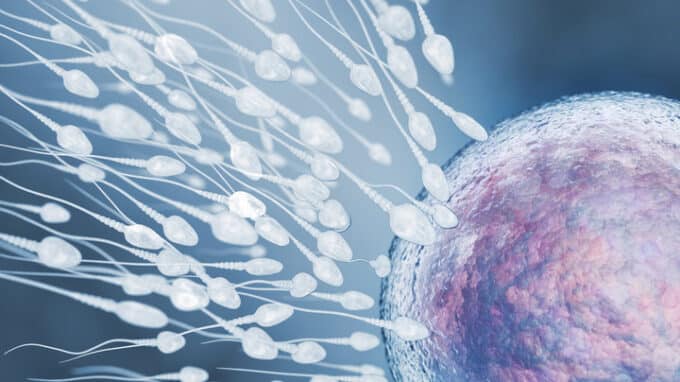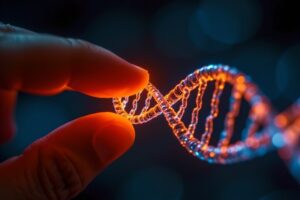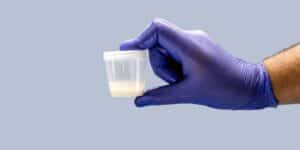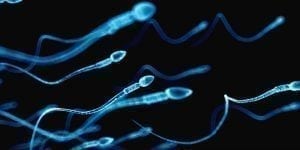Genetic mutations that can cause disease become increasingly common in sperm as men age. New research suggests that this is because certain DNA changes are actually favored during sperm production. In a large-scale study published in Nature, scientists from the Wellcome Sanger Institute and the TwinsUK study at King’s College London investigated how harmful DNA mutations accumulate throughout the sperm genome as men age. The results open up new avenues for research into how environmental and lifestyle factors could influence the genetic health of future generations.
In constantly renewing tissues, mutations (changes in DNA) can give some cells an advantage, allowing them to multiply faster than others. These groups of identical “clonal” cells then multiply and eventually outnumber their neighbors. While most mutations in the body’s normal cells (such as those in organs, connective tissue, and bones) are not passed on to children, mutations in sperm and egg cells can be inherited. Until recently, however, scientists lacked precise tools to measure how strongly certain mutations are favored in sperm.
Aging Amplifies Hidden Evolutionary Forces in Sperm and Ibcreases the Likelihood that Harmful Mutations Will be Passed on to Future Generations
To solve this problem, the team used NanoSeq, a high-precision DNA sequencing technology, to analyze sperm from 81 healthy men aged 24 to 75. The samples came from the TwinsUK cohort, the largest registry of adult twins in the United Kingdom, which provided a well-documented and diverse population for comparison. The data showed that about 2 percent of sperm from men in their early 30s carried disease-causing mutations. This proportion rose to 3 to 5 percent in men aged 43 to 74. Among the 70-year-old participants, 4.5 percent of sperm had harmful mutations, showing a clear link between age and genetic risk to offspring.
The increase is not solely due to random DNA errors that accumulate over time. Rather, a subtle form of natural selection within the testicles appears to give certain mutations a reproductive advantage, causing them to occur more frequently during sperm formation. The researchers identified 40 genes that appear to benefit from this process, many of which are associated with severe neurological developmental disorders in children and heritable cancer risks. While 13 of these genes were previously known to be involved, the new study shows that the phenomenon affects many more genes associated with cell growth and development than scientists had previously thought.
Although the number of sperm with harmful mutations increases with age, not all of these mutations lead to conception or a healthy pregnancy. Some may prevent fertilization or normal embryonic development, while others may cause miscarriages. Further studies are needed to determine how the increasing number of sperm mutations affects the health of children. By uncovering how mutations arise and are shaped by selection within sperm, researchers hope to refine the assessment of reproductive risks and better understand how genetics, lifestyle, and the environment interact across generations.
Research Highlights the Importance of Large, Population-Based Cohorts in Advancing Understanding of Human Development and Inheritance
In a complementary study also published in Nature, scientists at Harvard Medical School and the Sanger Institute examined the same phenomenon from a different angle by looking at mutations that had already been passed on to children, rather than those measured directly in sperm. By analyzing the DNA of over 54,000 parent-child trios and 800,000 healthy individuals, the team identified more than 30 genes in which mutations give sperm a competitive advantage, including, once again, many associated with rare developmental disorders and cancer, and many that overlap with the genes observed directly in sperm.
The study found that these mutations can increase the mutation rate of sperm by about 500-fold, which explains why some rare genetic disorders occur even though the parents do not carry the mutations in their own DNA. Interestingly, the study notes that these mutations are common in sperm, so it may appear that some genes cause a false-positive association with disease due to the increased mutation rate, rather than actually being linked to disease.
The work shows how natural selection within sperm can be observed directly in the DNA of children and influence their chances of inheriting certain genetic disorders. Dr. Matthew Neville, first author from the Wellcome Sanger Institute, said: “We expected to find some evidence of selection influencing mutations in sperm. What surprised us was how much this increases the number of sperm carrying mutations associated with serious diseases.“ Professor Matt Hurles, Director of the Wellcome Sanger Institute and co-author, said: ”Our findings reveal a hidden genetic risk that increases with the age of the father. Some changes in DNA not only survive but actually thrive in the testicles, meaning that fathers who father children later in life unknowingly have a higher risk of passing on a harmful mutation to their children.” Other researchers involved emphasize, among other things, the importance of large, population-based cohorts for advancing understanding of human development and inheritance.






